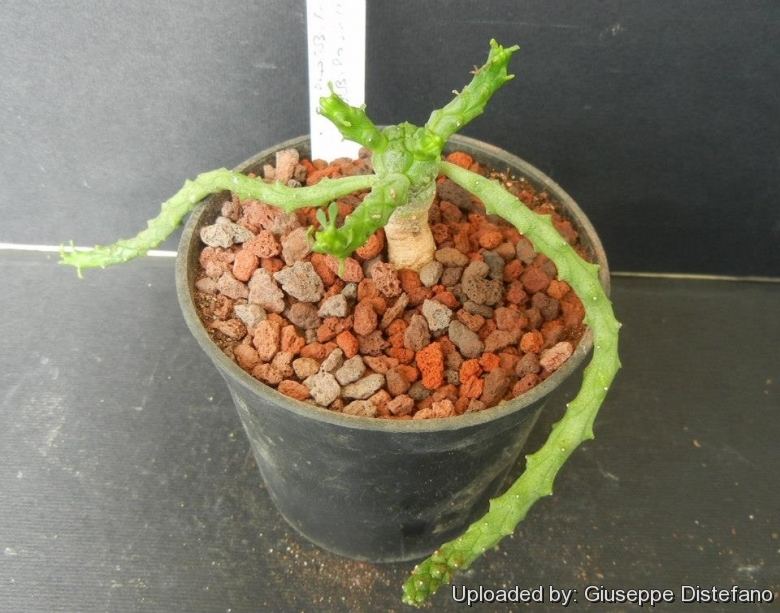




Your support is critical to our success.

Origin and Habitat: Republic of South Africa (Eastern Cape:Springbok Flats, east of Steytlerville, and west of Kirkwood). Extent of occurrence about 2 900 km2. With 5-10 locations.
Habitat and ecology: It grows on low, dry, stony hill slopes with sparse shrubby Karoo vegetation. It is potentially threatened by illegal collecting and degradation of the habitat by overgrazing and trampling by goats.
Synonyms:
- Euphorbia albipollinifera L.C.Leach
Description: Euphorbia albipolliniferaSN|27537]]SN|27537]], named after it's unusual pure white pollen, is one of the lesser known medusoid type euphorbias, with a subglobose body, tuberculate, central apical area and relatively few spreading branches up to 75 mm long.
Habit: It is a slow growing subglobose succulent shrublets, forming a good size caudex with medusa-like branches, lying flat on the ground.
Roots: Tuberous, tapering and merging into stem.
Stem: The main stem (caudex), can grow to five centimetres thick. It is partly buried in the ground arises from root forming a subglobose and slightly depressed body, the central growing point is tessellated with depressed tubercles at the centre. Branches few, spreading, out up to 7.5 cm long, up to 1 cm in diameter, with prominent tubercles.
Flowers (Cyathia): Solitary approx 7.5 mm in diameter, from branch-tips; peduncles to 20 mm long, more or less persistent and hardening. Nectar-glands circular, concave, green, quite separate.
Fruits: Subglobose, 5 x 6 mm, sparsely hairy, subsessile.
Seeds: Ovoid, 3 x 2.5 mm, minutely spiny.
Bibliography: Major references and further lectures
1) Domitilla Raimondo “Red list of South African plants 2009” South African National Biodiversity Institute, 2009
2) James Cullen, Sabina G. Knees, H. Suzanne Cubey “The European Garden Flora Flowering Plants: A Manual for the Identification of Plants Cultivated in Europe, Both Out-of-Doors and Under Glass” Cambridge University Press, 11/ago/2011
3) Urs Eggli “Illustrated Handbook of Succulent Plants: Dicotyledons” Springer, 2002
4) Doreen Court “Succulent Flora of Southern Africa” CRC Press, 01/giu/2000
Cultivation and Propagation: Euphorbia albipolliniferaSN|27537]]SN|27537]] is a relatively slow growing species and will form a good size caudex. If you are new to succulents, this is a good species to try since it's easy to grow.
Exposure: It likes a sunny position, but can tolerate moderate shade, and a plant that has been growing in shade should be slowly hardened off before placing it in full sun as the plant will be severely scorched if moved too suddenly from shade into sun.
Soil: It does best in a mineral soil, but is tolerant of a wide range of soil types. Good drainage is essential. In pots give the plant an airy growing medium which mainly consists of non organic material such us clay, pumice, lava grit, and only a little peat or leaf-mould.
Repotting: It like quite small pots, repott in very later winter, early spring.
Watering: Water sparingly from March to September. No water should ever be allowed to stand around the roots. Keep almost completely dry in winter.
Plant Pests: Prone to mealy bugs and rarely scale.
Rot: Rot it is only a minor problem with Euphorbias if the plants are watered and “aired” correctly. If they are not, fungicides won't help all that much.
Propagation: The plant can be reproduced by seeds or cuttings If you take a cutting from this plant, you will get a strange bunch of sideways 'fingers' that will not come true to the shape of the parent. In this case, wait for seed. If you remove an offset, remember to let it dry for some days, letting the wound heal (cuttings planted too soon easily rot before they can grow roots). Lay it on the soil and insert the stem end partially into the substrate. Try to keep the cutting somewhat upright so that the roots are able to grow downward. It is better to wash the cut to remove the latex.
Warning: As with all other Euphorbias when a plant get damaged it exudes a thick white milky sap known as latex. The latex is a violent emetic and purgative and is used by natives for the purpose of curing indigestion and constipation. The sap is highly irritant, however. A case of death from drinking a concoction of the plant is on record. A yellow resinous substance in this plant called Euphorbin can cause terrible blistering of the skin.
| Your Actions | |
|---|---|
| Back to Euphorbia index | |
| Back to Euphorbiaceae index | |
 |
Back to Succulents Encyclopedia index |
Privacy stantement - Terms and conditions - How to cite - About us - Feedback - Donate




